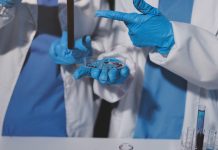Hydrogen fuel cells are a promising technology for producing clean and renewable energy, but the cost and activity of their cathode materials is a major challenge for commercialization. Many fuel cells require expensive platinum-based catalysts to help convert renewable fuels into electrical energy. In the search for more affordable catalysts that provide the same efficiency as pure platinum, researchers at the University of Akron developed a new method of synthesizing catalysts from a combination of metals—platinum and nickel—that form octahedral (eight-sided) shaped nanoparticles.
While scientists have identified this catalyst as one of the most efficient replacements for pure platinum, they have not fully understood why it grows in an octahedral shape. To better understand the growth process, the researchers at the University of Akron collaborated with multiple institutions, including Brookhaven and its NSLS-II.
The team used a research technique called ambient-pressure X-ray photoelectron spectroscopy (AP-XPS) to study the surface composition and chemical state of the metals in the nanoparticles during the growth reaction. “In this technique, we direct x-rays at a sample, which causes electrons to be released. By analysing the energy of these electrons, we are able to distinguish the chemical elements in the sample, as well as their chemical and oxidation states.” said Iradwikanari Waluyo, lead scientist at IOS and a co-corresponding author of the research paper.
The researchers discovered that, during the growth reaction, metallic platinum forms first and becomes the core of the nanoparticles. Then, when the reaction reaches a slightly higher temperature, platinum helps form metallic nickel, which later segregates to the surface of the nanoparticle. In the final stages of growth, the surface becomes roughly an equal mixture of the two metals. This interesting synergistic effect between platinum and nickel plays a significant role in the development of the nanoparticle’s octahedral shape, as well as its reactivity. Their findings are published in Nature Communications.
One of the advantages of these findings is that nickel is a cheap material, whereas platinum is expensive, so, if the nickel on the surface of the nanoparticle is catalysing the reaction, and these nanoparticles are still more active than platinum by itself, then hopefully, with more research, we can figure out the minimum amount of platinum to add and still get the high activity, creating a more cost-effective catalyst, said the team.
The researchers further plans to explore the catalytic properties of the faceted nanoparticles to understand the structure-property correlation.

































